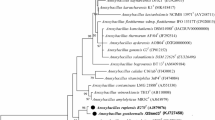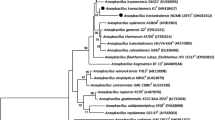Abstract
In the present study, we aim to clarify the taxonomic positions of Anoxybacillus salavatliensis DSM 22626T and Anoxybacillus gonensis G2T by using whole genome phylogenetic analysis, biochemical and chemotaxonomic characteristics. The genome sequences of A. salavatliensis DSM 22626T was not available in any database, so it was sequenced in this study. In phylogenetic trees drawn using whole genome sequences and 16S rRNA gene sequences, A. salavatliensis DSM 22626T and A. gonensis G2T clade together and showed high sequence similarity (99.3%) based on 16S rRNA gene. The average amino acid identity, average nucleotide identity and digital DNA–DNA hybridization values between A. salavatliensis DSM 22626T and A. gonensis G2T were found to be greater than the threshold values for species demarcation. Further, the phylogenomic analysis based on the core genome of the strains under study confirmed that A. salavatliensis DSM 22626T and A. gonensis G2T formed a monophyletic clade. Most phenotypic and chemotaxonomic features between both strains were almost identical except for a few exceptions. The present results show that A. salavatliensis DSM 22626T is a later heterotypic synonym of A. gonensis G2T.




Similar content being viewed by others
References
Arkin AP, Cottingham RW, Henry CS et al (2018) KBase: the United States department of energy systems biology knowledgebase. Nat Biotechnol 36:566–569
Aziz RK, Bartels D, Best AAB et al (2008) The RAST server: rapid annotations using subsystems technology. BMC Genomics 9:75. https://doi.org/10.1186/1471-2164-9-75
Belduz AO, Dulger S, Demirbag Z (2003) Anoxybacillus gonensis sp. nov., a moderately thermophilic, xylose-utilizing, endospore-forming bacterium. Int J Syst Evol Microbiol 53:1315–1320
Cihan AC, Ozcan B, Cokmus C (2011) Anoxybacillus salavatliensis sp. nov., an α-glucosidase producing, thermophilic bacterium isolated from Salavatli. Turk J Basic Microbiol 51:136–146
Collins MD (1985) Analysis of isoprenoid quinones. Methods Microbiol 18:329–366
Euzéby J (2011) List of new names and new combinations previously effectively, but not validly, published. Validation List no. 138. Int J Syst Evol Microbiol 61:475–476. https://doi.org/10.1099/ijs.0.032003-0
Farris JS (1972) Estimating phylogenetic trees from distance matrices. Am Nat 106(951):645–667
Felsenstein J (1981) Evolutionary trees from DNA sequences: a maximum likelihood approach. J Mol Evol 17:368–376. https://doi.org/10.1007/bf01734359
Hall TA (1999) BioEdit: a user-friendly biological sequence alignment editor and analysis program for Windows 95/98/NT. Nucleic Acids Symp Ser 41:95–98
Kimura M (1980) A simple method for estimating evolutionary rates of base substitutions through comparative studies of nucleotide sequences. J Mol Evol 16:111–120. https://doi.org/10.1007/bf01731581
Kluge AG, Farris JS (1969) Quantitative phyletics and the evolution of Anurans. Syst Zool 18:1–32
Lee I, Ouk Kim Y, Park SC, Chun J (2016) OrthoANI: an improved algorithm and software for calculating average nucleotide identity. Int J Syst Evol Microbiol 66(2):1100–1103
Lefort V, Desper R, Gascuel O (2015) FastME 2.0: a comprehensive, accurate, and fast distance-based phylogeny inference program. Mol Biol Evol 32:2798–2800
Li L, Stoeckert CJ, Roos DS (2003) OrthoMCL: identifcation of ortholog groups for eukaryotic genomes. Genome Res 13:2178–2189
Liu GH, Rao MPN, Dong ZY, Wang JP, Che JM, Chen QQ, Sengonca C, Liu B, Li WJ (2019) Genome-based reclassifcation of Bacillus plakortidis Borchert et al. 2007 and Bacillus lehensis Ghosh et al. 2007 as a later heterotypic synonym of Bacillus oshimensis Yumoto et al. 2005; Bacillus rhizosphaerae Madhaiyan et al. 2011 as a later heterotypic synonym of Bacillus clausii Nielsen et al. 1995. Antonie Van Leeuwenhoek 112:1725–1730. https://doi.org/10.1007/s10482-019-01299-z
Luo C, Rodriguez-R LM, Konstantinidis KT (2014) MyTaxa: an advanced taxonomic classifier for genomic and metagenomic sequences. Nucleic Acids Res 42:8. https://doi.org/10.1093/nar/gku169
Meier-Kolthoff JP, Göker M (2019) TYGS is an automated high-throughput platform for state-of-the-art genome-based taxonomy. Nat Commun 10(1):2182
Meier-Kolthoff JP, Auch AF, Klenk HP, Göker M (2013) Genome sequence-based species delimitation with confidence intervals and improved distance functions. BMC Bioinform 14:60
Orata FD, Meier-Kolthoff JP, Sauvageau D, Stein LY (2018) Phylogenomic analysis of the gammaproteobacterial methanotrophs (Order Methylococcales) calls for the reclassification of members at the genus and species levels. Front Microbiol 9:3162
Pikuta E, Lysenko A, Chuvilskaya N, Mendrock U et al (2000) Anoxybacillus pushchinensis gen. nov., sp. nov., a novel anaerobic, alkaliphilic, moderately thermophilic bacterium from manure, and description of Anoxybacillus flavithermus comb. nov. Int J Syst Evol Microbiol 50:2109–2117
Pikuta E, Cleland D, Tang J (2003) Aerobic growth of Anoxybacillus pushchinoensis K1T: emended descriptions of A. pushchinoensis and the genus Anoxybacillus. Int J Syst Evol Microbiol 53:1561–1562
Price MN, Dehal PS, Arkin AP (2010) FastTree 2–approximately maximum-likelihood trees for large alignments. PLoS One 5:e9490
Rao MPN, Xiao M, Liu D, Tang R, Liu G, Li W (2022) Genome-based reclassifcation of Evansella polygoni as a later heterotypic synonym of Evansella clarkii and transfer of Bacillus shivajii and Bacillus tamaricis to the genus Evansella as Evansella shivajii comb. Nov. and Evansella tamaricis comb. nov. Arch Microbiol 204:47. https://doi.org/10.1007/s00203-021-02720-w
Richter M, Rossello-Mora M (2009) Shifting the genomic gold standard for the prokaryotic species definition. Proc Natl Acad Sci USA 06(45):19126–19131. https://doi.org/10.1073/pnas.0906412106
Saitou N, Nei M (1987) The neighbor-joining method: a new method for reconstructing phylogenetic trees. Mol Biol Evol 4:406–425. https://doi.org/10.1093/oxfordjournals.molbev.a040454
Seemann T (2014) Prokka: rapid prokaryotic genome annotation. Bioinformatics 30:2068–2069
Thompson JD, Higgins DG, Gibson TJ (1994) CLUSTAL W: improving the sensitivity of progressive multiple sequence alignment through sequence weighting, position-specifc gap penalties and weight matrix choice. Nucleic Acids Res 22:4673–4680. https://doi.org/10.1093/nar/22.22.4673
Tindall BJ (1990a) A comparative study of the lipid composition of Halobacterium saccharovorum from various sources. Syst Appl Microbiol 13:128–130
Tindall BJ (1990b) Lipid composition of Halobacterium lacusprofundi. FEMS Microbiol Lett 66:199–202
Tindall BJ, Sikorski J, Smibert RM, Krieg NR (2007) Phenotypic characterization and the principles of comparative systematics. In: Reddy CA, Beveridge TJ, Breznak JA, Marzluf G, Schmidt TM, Snyder LR (eds) Methods for general and molecular microbiology, 3rd edn. American Society for Microbiology, Washington, DC, pp 330–393
Wattam AR, Davis JJ, Assaf R et al (2017) Improvements to PATRIC, the all-bacterial bioinformatics database and analysis resource center. Nucleic Acid Res 45:D535–D542. https://doi.org/10.1093/nar/gkw1017
Wayne LG, Brenner DJ, Colwell RR et al (1987) International committee on systematic bacteriology. Report of the ad hoc committee on reconciliation of approaches to bacterial systematics. Int J Syst Bacteriol 37:463–464
Yoon SH, Ha SM, Kwon S, Lim J, Kim Y, Seo H, Chun J (2017a) Introducing EzBioCloud: a taxonomically united database of 16S rRNA and whole genome assemblies. Int J Syst Evol Microbiol 67:1613–1617
Yoon SH, Ha SM, Lim J, Kwon S, Chun J (2017b) A large-scale evaluation of algorithms to calculate average nucleotide identity. Antonie Van Leeuwenhoek 110(10):1281–2128. https://doi.org/10.1007/s10482-017-0844-4
Acknowledgements
This study was supported by Karadeniz Technical University (KTU BAP FAT-2019-7822).
Funding
This work received no specific grant from any funding agency.
Author information
Authors and Affiliations
Contributions
KIB designed the study. KIB, HIG and SC performed genome analysis and analysed the data. KIB, HIG and AOB performed the phenotypic and chemotaxonomic analysis. KIB wrote the manuscript. All authors read and approved the final manuscript.
Corresponding author
Ethics declarations
Conflict of interest
The authors declare that there is no conflict of interest.
Ethical approval
This article does not contain any studies with human participants or animals performed by any of the authors.
Additional information
Publisher's Note
Springer Nature remains neutral with regard to jurisdictional claims in published maps and institutional affiliations.
Supplementary Information
Below is the link to the electronic supplementary material.
Rights and permissions
Springer Nature or its licensor (e.g. a society or other partner) holds exclusive rights to this article under a publishing agreement with the author(s) or other rightsholder(s); author self-archiving of the accepted manuscript version of this article is solely governed by the terms of such publishing agreement and applicable law.
About this article
Cite this article
Inan Bektas, K., Guler, H.İ., Canakci, S. et al. Genome-based reclassification of Anoxybacillus salavatliensis Cihan et al. 2011 as a later heterotypic synonym of Anoxybacillus gonensis Belduz et al. 2003. Antonie van Leeuwenhoek 116, 415–423 (2023). https://doi.org/10.1007/s10482-023-01813-4
Received:
Accepted:
Published:
Issue Date:
DOI: https://doi.org/10.1007/s10482-023-01813-4




